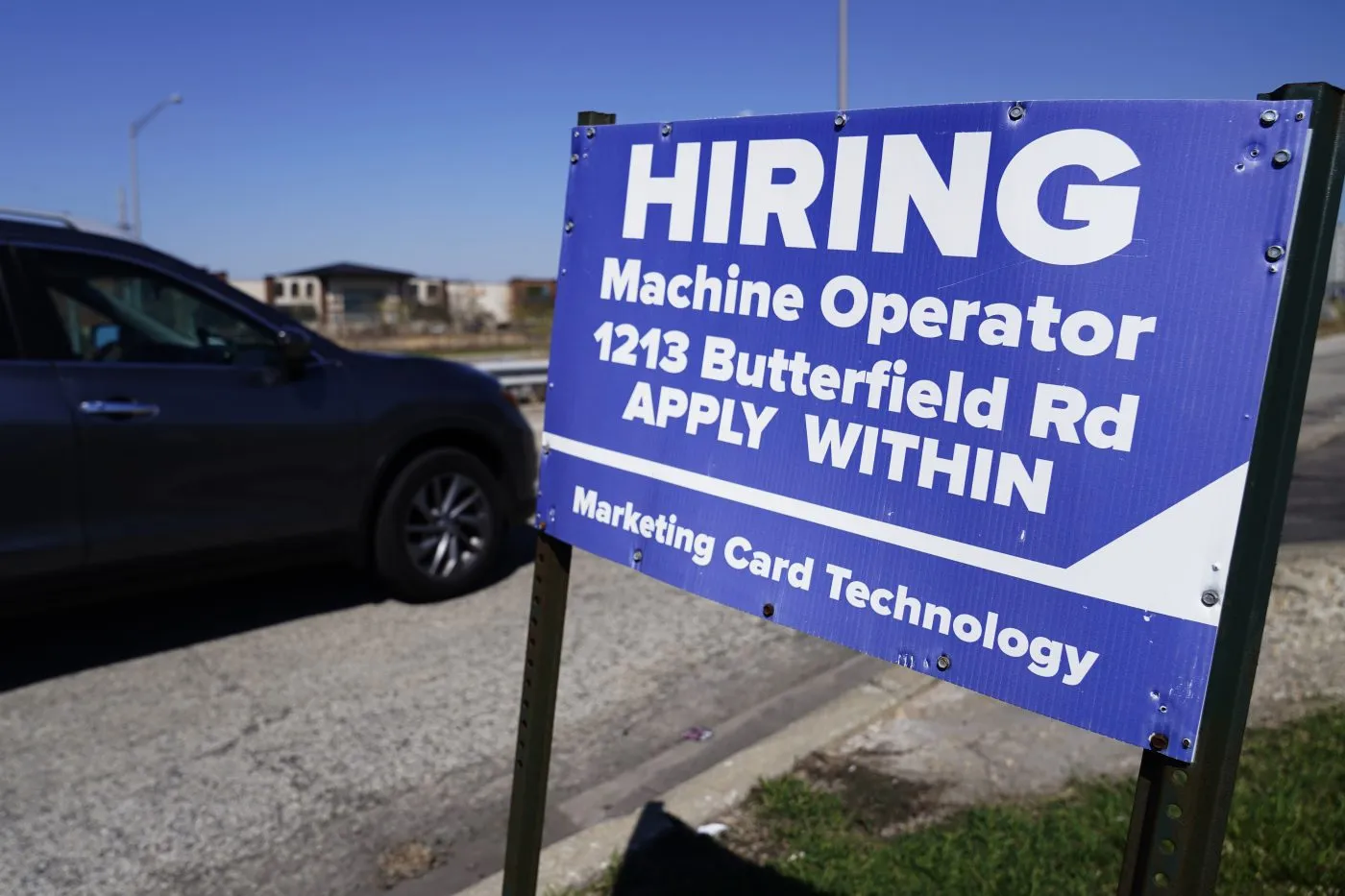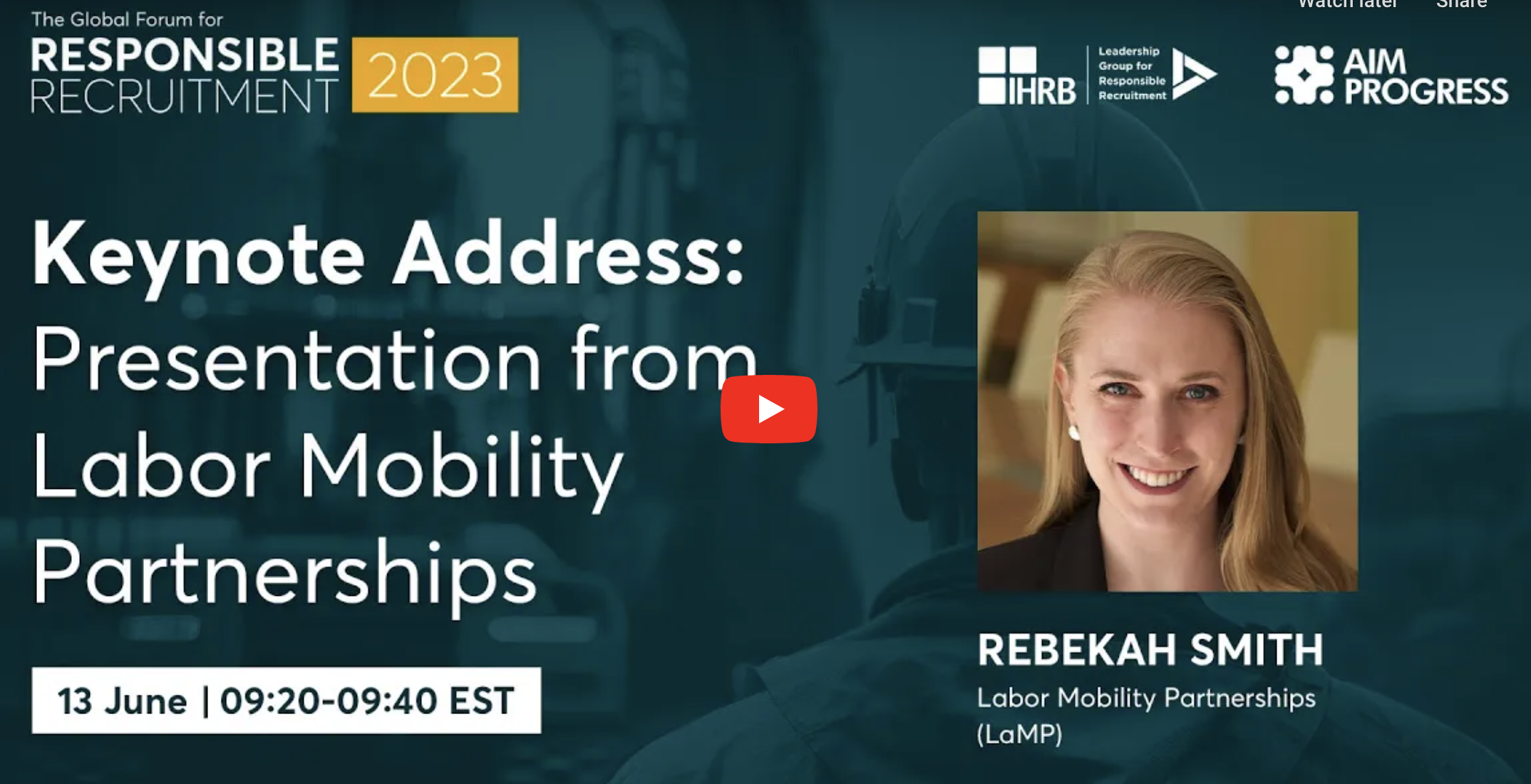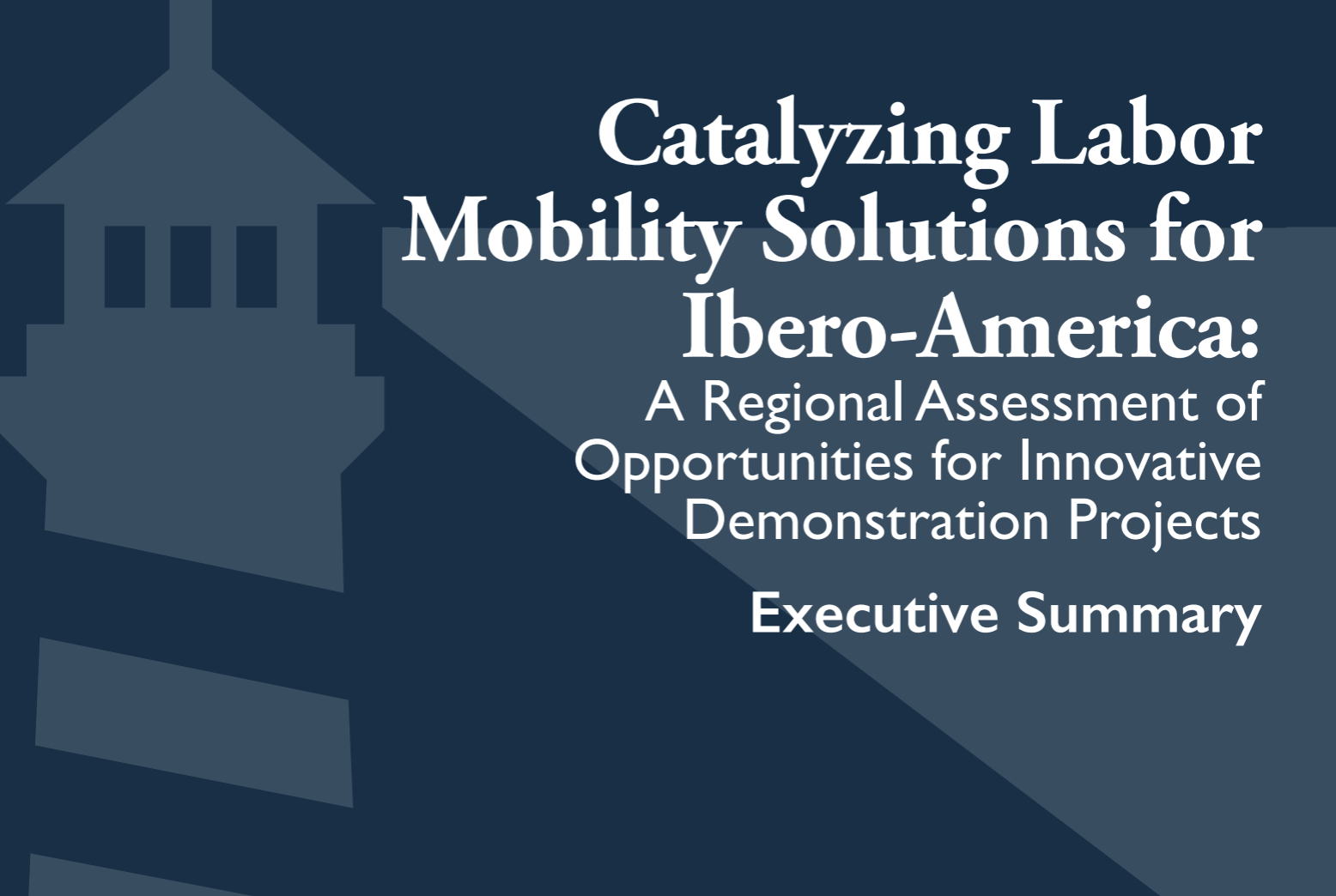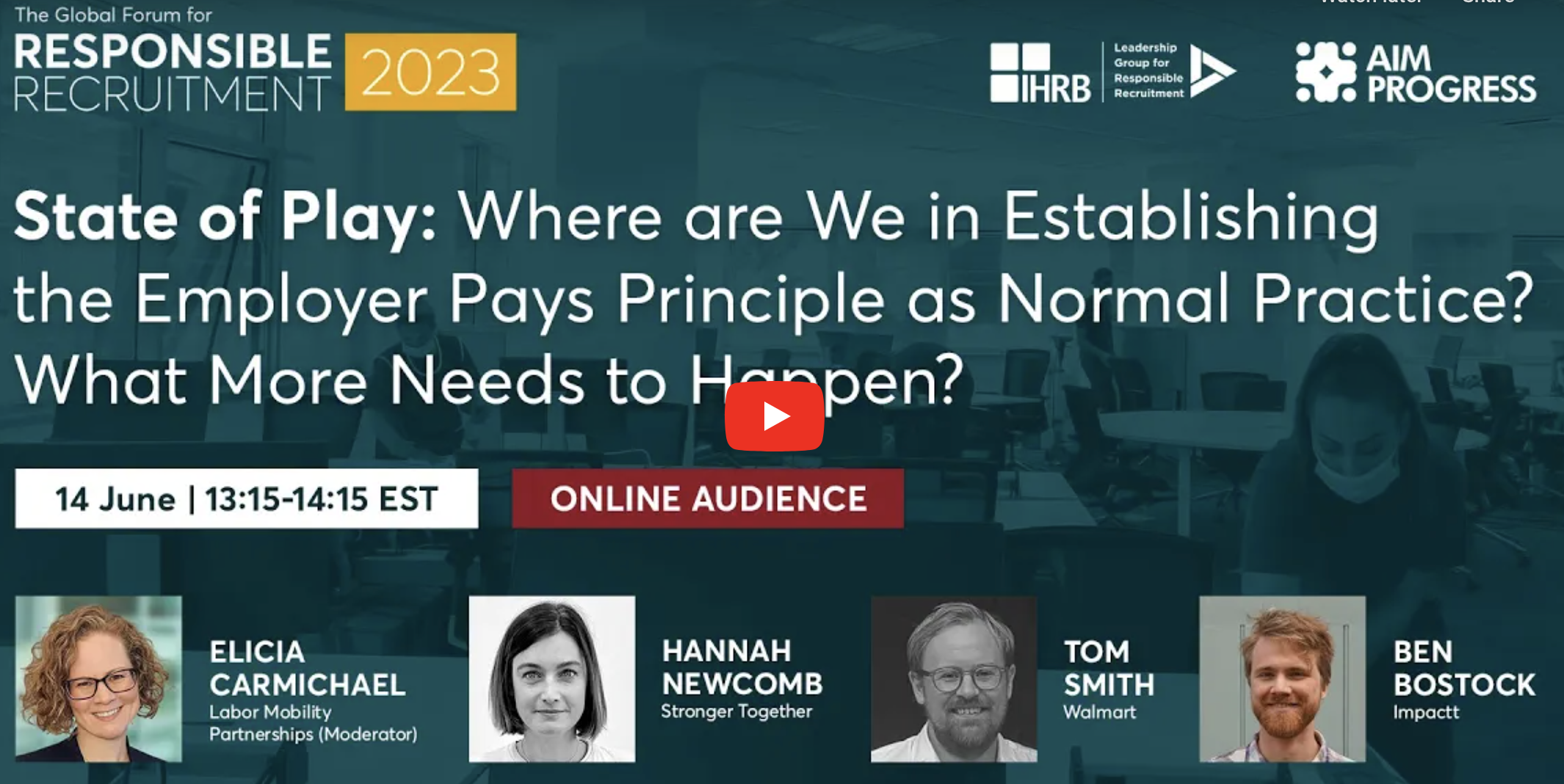LaMP’s Executive Director Rebekah Smith gave the keynote address for The Global Forum for Responsible Recruitment‘s 2023 annual conference in New York City.
Keynote Address Transcript:
Privilege to be here with you all to present a vision for a professionalized recruitment industry that can be the key to unlocking migration and transforming the lives of millions of workers and their families.
This conference and our community have traditionally focused on the dangers of unethical recruitment and how to stop them. Today I want to shift our view to the transformative positive potential of migration done well.
We live in a unique era where the dynamics around migration will be transformed by two parallel and historic trends:
First, the era of “forever labor shortages” in high-income countries. With more older people and fewer young people in countries like the US and Europe, we are entering an era of aging societies where all industries suffer from a severe lack of workers.
In the last few years, we have all felt this in many parts of our lives – think of all the long waits at the airport, people struggling to get care for children and aging parents, the breakdown of supply chains driving inflation because there are not enough truck drivers and port workers.
These worker gaps are already costing the global economy 3-7 billion dollars every day and are going to get far worse from here.
Without migration, by 2050, OECD countries will lose 92 million working age people and gain 96 million elderly people, meaning that they will need an additional 400+ million workers beyond what we can expect from native birth rates by 2050 jut to maintain their social structures.
In the past, our response to labor shortages in a given sector has been to raise wages and make that sector more attractive. In a world where there are too few workers to go around, you can’t solve labor shortages by simply recruiting workers away from another sector – that just creates another shortage. Here’s how bad it is already: in the US by 2028, the number of new workers in the entire economy will not be enough to fill labor needs in JUST the elderly and child care sector, let alone the rest of the economy.
Increased recruitment of foreign workers is the only realistic solution, since the other solutions – like making elderly people work longer or having more children – are not viable. This means that thinking about recruitment has to shift from cleaning up supply chains alone to securing and cleaning supply chains if businesses are to remain functional.
At the same time, low-income countries face the exact opposite problem of high-income countries – not enough jobs for their workers.
The number of workers is growing far faster than the number of jobs in countries where underemployment and poverty are already defining features of life for far too many. In the same time frame that high-income countries need an additional 400M workers, low-income countries will have an additional 1.4 billion workers, 600M of whom are not likely to be able to find jobs in their home countries. In Africa already today, between 10 million and 12 million new youth become working age each year, but only 3.1 million jobs are created.
Think back to what I said – the global economy is already losing 3-7 billion dollars every day because of jobs going unfilled, and at the exact same time, 9 million African youth each year are entering the workforce with little to no hope of finding a good job at home.
Hopefully the sheer waste is obvious, but it is also fundamentally a matter of justice – when we look at what explains differences in income between people around the world, where they are is the single most important factor. As my co-founder Lant Pritchett likes to say, it turns out there are not poor people but only people in poor places. And as we just covered, there’s going to be a lot more of them in the coming decades. This means that one of the most powerful things companies can do to strengthen global equality is to hire more workers from abroad, and yet we have often viewed this as a risk to manage rather than something to celebrate.
Let me try to put into context what the opportunity to work abroad means for a migrant worker. On average, the exact same worker, born in a low-income country but doing the exact same job abroad, can expect to increase their income by 5 to 15 times, even adjusting for higher expenses living in a high-income country. Think about what you would do to multiply your current salary by 10.
For workers and their families born into poverty, the chance to work abroad represents food on the table, life-saving healthcare, sending their children to school. The impact of it dwarfs all foreign aid and charitable giving.
This means that the demographics I told you about earlier represent a historic opportunity to transform labor markets to the benefit of the most vulnerable: if we were to fill the jobs that need to be filled in high-income countries, by bringing in workers from low-income countries, we would create additional trillions in increased global income, largely accruing to people born into poverty. For me personally, this is why I’m at this conference today.
But at the same time that these trends create a historic opportunity, they also put significantly more pressure on recruitment systems. Far more workers would like to work abroad than are able to under the current system. Recruiters in many contexts control who gets access to this golden ticket, putting much of the power in their hands and driving many of the issues we are here to talk about at this conference.
The pressure of increasing numbers of young people unable to get good jobs in their home country, paired with lucrative but empty jobs in countries like the US and Europe, will increase risks of recruitment fraud and human trafficking if we don’t act effectively and swiftly.
Many of the problems we see in recruitment systems – and that we are gathered around today – are a direct result of these pressures, as well as recruitment systems that are designed in a way that actively creates incentives for fraud and malpractice.
These bad outcomes have delegitimized migration, such that the first thing people think of is not its enormous potential for good, but the risks and abuses migrants so frequently face.
So, recruitment is both the challenge and – to some extent – the solution to unlocking the potential of migration.
It won’t surprise anyone in this room that politics are the primary barrier to letting these workers fill needed jobs.
But in the course of our work, we’ve learned two things that might surprise you:
The first is that – for the most part – political resistance to foreign workers isn’t driven by racism or xenophobia – its driven by very valid concerns about the way that migration is currently happening, the same concerns that brought you to this conference today. Most voters fall into what is called the “anxious middle” – people who are not very for or very against migration, but rather are concerned about abuse and exploitation of migrants, irregular migration, and visa overstay. As we just discussed, many of these challenges are driven specifically by problems within recruitment systems.
As long as voters and policymakers see the movement of people as dominated by human traffickers and smugglers and recruiters and employers who take advantage of those who move, a massive opportunity for improving the human condition around the world will remain off the agenda. The flip side of this is that by building a professional and responsible recruitment industry, we can directly answer these concerns and build political support to expand migration.
The second thing that might surprise you is that even when access is not limited by policy, it is limited by [practice]. Many countries are beginning to open up their migration systems – Japan, Germany, Canada have all made major strides in the last 3 years to welcome significantly more foreign workers. And yet workers are not moving through these visas, because missing infrastructure and services has rendered them inaccessible. These visas are unfilled because the systems are too complex for employers and workers to navigate without support, and we haven’t developed a professional industry delivering these the support services in time to take advantage of these opportunities.
This is where we get to the positive role of the recruitment industry. We’ve spent so much time focusing on the harms caused by today’s recruitment systems, that we sometimes lose sight of the critical and positive role of recruiters in well-functioning migration systems.
A sustainable responsible recruitment industry is core to ensuring that we can scale migration while managing it in a way that workers are well prepared, placed, and protected throughout the migration experience.
There is plenty of evidence that recruiters play a significant role in reducing barriers and frictions for both workers and employers throughout the entire migration process by building and circulating specialized knowledge of migration opportunities and how to navigate these complex systems. As immigration processes in receiving countries become more complex, the assistance of an intermediary who can help migrants navigate processes which are time-consuming and costly has become increasingly essential.
It is also critical to ensuring that employers of all sizes are able to hire foreign workers – with growing need to recruit foreign workers, companies traditionally not acquainted with the immigration system will require extensive support to navigate the systems and hire the people they need.
There’s a strong economic case for this industry to exist at scale: The economic gains to employers and workers from filling half of the need would look something like 3 trillion dollars annually. If only 1 percent – a conservative estimate – of the aggregate gains were spent on mobility industry services, this would imply a 30 billion dollar per year industry.
As a community, we need to shift the timeframes we center our work on. By focusing mainly on present day harms of irresponsible recruitment, we risk designing solutions that miss the opportunity to catalyze the future transformative potential of well-managed and supported migration. We will not succeed if we focus mainly on suppressing and reforming the activities of our present undesirable industry – the draw of migration is simply too powerful. The way we will succeed in transforming recruitment is by building a strong foundation for the growth of a professional, sustainable, responsible recruitment industry.
We can look to the evolution of other sectors to envision the emergence of such an industry.
Many of you likely took a plane to get here – being able to travel safely across countries or even hemispheres is something we take for granted as part of our daily lives. But in the 1930s, air travel was dangerous and unreliable, to the point that one might have easily pointed to the overwhelming challenges of creating a safe, reliable, convenient, and affordable airline industry. We can think of today’s recruitment industry in much the same way – decentralized, without proper regulation or enforcement of standards, leaving the clients – workers – at significant risk.
So, what happened to turn the airline industry from a small-scale and dangerous operation, to the vast and reliable industry that it is today?
The answer is decades of concerted, dedicated, (and government supported) effort to create all of the necessary infrastructures: standards, monitoring, enforcement mechanisms, and the consolidation of airlines competing to provide the best value proposition to their customers. They recognized that an airplane accident happening anywhere was an accident happening everywhere, and worked together to build a competitive industry that jointly reinforced standards of safety.
We have made notable strides in recent years in international recruitment; the launch of IRIS was an important step to articulating quality standards; we have seen companies take on additional local staff to guide their suppliers, training on better recruitment practice for recruiters and suppliers, and companies making repayments to workers who are found to have paid fees. Governments are taking the notable step of embedding recruitment quality requirements in trade agreements like the recent one between US and Taiwan.
But as demographic pressures intensify and immigration policies open, it is a matter of increasing urgency to transform the industry and deliver professional recruitment services at scale.
This requires new scalable and sustainable solutions: developing economically viable responsible recruitment models through financial solutions to reduce risk and timing issues for employers and recruiters, building technology that increases transparency and worker feedback, building recruitment models that give workers greater power as clients, and associations of responsible recruiters with a vested interest in holding themselves accountable. We envision a global responsible recruitment industry that, much like the airlines, sees abuse in one corridor as a threat to business in every corridor.
The people in this room (and online) are well positioned to help guide us to this new world. More than anyone, you have given deep thought to what a better recruitment industry would look like. It is up to us now to expand the tent and invite new types of partners in – from worlds like finance and incubators and accelerators to support new recruitment startups, getting all hands on deck and expanding our skills to build this industry.
We need to counter narratives that portray migrants only as victims by designing mechanisms that increase their agency and acknowledge the powerful impact of migration on their lives, and as businesses we need to own our part of this impact and advocate for expanded visa pathways not only to address labor needs, but as part of a robust global economic inclusion strategy that acknowledges that in today’s world your economic opportunity depends on where you are much more than who you are. Together, we can build a good industry and an industry for good, and transform labor markets so that – for all workers around the world – their opportunity reflects their potential, not just the circumstances of their birth. Thank you.




 LaMP looks to create new safe and legal mobility pathways to OECD countries, but also to improve the quality and utilization (quantity) of existing pathways. Germany is one of the first OECD countries to create a scaled visa route for mid-skilled workers. To capitalize on this opening, the Indian government in 2022 collaborated with Germany to produce the German-Indian Migration Mobility Agreement. Recruitment agencies in India have reported a significant increase in worker demand for job opportunities in Germany (40-70% Indians desire to work abroad, with Germany as a top-5 destination for migration).
LaMP looks to create new safe and legal mobility pathways to OECD countries, but also to improve the quality and utilization (quantity) of existing pathways. Germany is one of the first OECD countries to create a scaled visa route for mid-skilled workers. To capitalize on this opening, the Indian government in 2022 collaborated with Germany to produce the German-Indian Migration Mobility Agreement. Recruitment agencies in India have reported a significant increase in worker demand for job opportunities in Germany (40-70% Indians desire to work abroad, with Germany as a top-5 destination for migration). 












